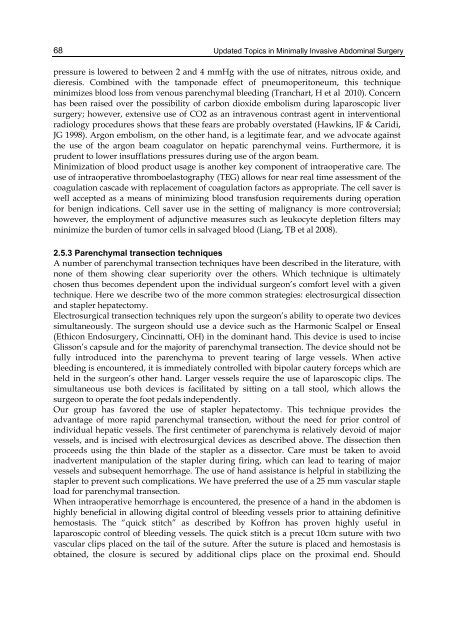UPDATED TOPICS IN MINIMALLY INVASIVE ABDOMINAL SURGERY
UPDATED TOPICS IN MINIMALLY INVASIVE ABDOMINAL SURGERY
UPDATED TOPICS IN MINIMALLY INVASIVE ABDOMINAL SURGERY
Create successful ePaper yourself
Turn your PDF publications into a flip-book with our unique Google optimized e-Paper software.
68<br />
Updated Topics in Minimally Invasive Abdominal Surgery<br />
pressure is lowered to between 2 and 4 mmHg with the use of nitrates, nitrous oxide, and<br />
dieresis. Combined with the tamponade effect of pneumoperitoneum, this technique<br />
minimizes blood loss from venous parenchymal bleeding (Tranchart, H et al 2010). Concern<br />
has been raised over the possibility of carbon dioxide embolism during laparoscopic liver<br />
surgery; however, extensive use of CO2 as an intravenous contrast agent in interventional<br />
radiology procedures shows that these fears are probably overstated (Hawkins, IF & Caridi,<br />
JG 1998). Argon embolism, on the other hand, is a legitimate fear, and we advocate against<br />
the use of the argon beam coagulator on hepatic parenchymal veins. Furthermore, it is<br />
prudent to lower insufflations pressures during use of the argon beam.<br />
Minimization of blood product usage is another key component of intraoperative care. The<br />
use of intraoperative thromboelastography (TEG) allows for near real time assessment of the<br />
coagulation cascade with replacement of coagulation factors as appropriate. The cell saver is<br />
well accepted as a means of minimizing blood transfusion requirements during operation<br />
for benign indications. Cell saver use in the setting of malignancy is more controversial;<br />
however, the employment of adjunctive measures such as leukocyte depletion filters may<br />
minimize the burden of tumor cells in salvaged blood (Liang, TB et al 2008).<br />
2.5.3 Parenchymal transection techniques<br />
A number of parenchymal transection techniques have been described in the literature, with<br />
none of them showing clear superiority over the others. Which technique is ultimately<br />
chosen thus becomes dependent upon the individual surgeon’s comfort level with a given<br />
technique. Here we describe two of the more common strategies: electrosurgical dissection<br />
and stapler hepatectomy.<br />
Electrosurgical transection techniques rely upon the surgeon’s ability to operate two devices<br />
simultaneously. The surgeon should use a device such as the Harmonic Scalpel or Enseal<br />
(Ethicon Endosurgery, Cincinnatti, OH) in the dominant hand. This device is used to incise<br />
Glisson’s capsule and for the majority of parenchymal transection. The device should not be<br />
fully introduced into the parenchyma to prevent tearing of large vessels. When active<br />
bleeding is encountered, it is immediately controlled with bipolar cautery forceps which are<br />
held in the surgeon’s other hand. Larger vessels require the use of laparoscopic clips. The<br />
simultaneous use both devices is facilitated by sitting on a tall stool, which allows the<br />
surgeon to operate the foot pedals independently.<br />
Our group has favored the use of stapler hepatectomy. This technique provides the<br />
advantage of more rapid parenchymal transection, without the need for prior control of<br />
individual hepatic vessels. The first centimeter of parenchyma is relatively devoid of major<br />
vessels, and is incised with electrosurgical devices as described above. The dissection then<br />
proceeds using the thin blade of the stapler as a dissector. Care must be taken to avoid<br />
inadvertent manipulation of the stapler during firing, which can lead to tearing of major<br />
vessels and subsequent hemorrhage. The use of hand assistance is helpful in stabilizing the<br />
stapler to prevent such complications. We have preferred the use of a 25 mm vascular staple<br />
load for parenchymal transection.<br />
When intraoperative hemorrhage is encountered, the presence of a hand in the abdomen is<br />
highly beneficial in allowing digital control of bleeding vessels prior to attaining definitive<br />
hemostasis. The “quick stitch” as described by Koffron has proven highly useful in<br />
laparoscopic control of bleeding vessels. The quick stitch is a precut 10cm suture with two<br />
vascular clips placed on the tail of the suture. After the suture is placed and hemostasis is<br />
obtained, the closure is secured by additional clips place on the proximal end. Should














![focuspdca.ppt [Compatibility Mode]](https://img.yumpu.com/22859457/1/190x146/focuspdcappt-compatibility-mode.jpg?quality=85)


